

Open Source Physics. Computational Resources for Teaching The OSP Collection provides curriculum resources that engage students in physics, computation, and computer modeling.

Computational physics and computer modeling provide students with new ways to understand, describe, explain, and predict physical phenomena. Browse the OSP simulations or learn more about our tools and curriculum pieces below. Tracker The Tracker tool extends traditional video analysis by enabling users to create particle models based on Newton's laws. Learn more about Tracker Curriculum Packages OSP curriculum packages combine computer simulations with tutorial materials and student worksheets.
Browse curriculum resources by topic and learn how to customize packages Featured Curriculum Package Ghostly Images JS Package The Ghostly Images Package contains Javascript models and worksheets for 1D kinematics to illustrate the connection between motion diagrams ("ghostly images") and position-time plots. EJS Modeling Learn more about EJS Tools. Forces in 1 Dimension - Force, Motion, Friction. E13. E25. Name That Motion Interactive. Using the Interactive The Name That Motion Interactive is shown in the iFrame below.
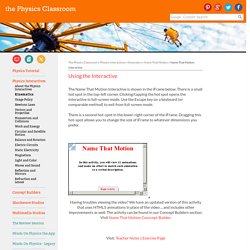
There is a small hot spot in the top-left corner. Clicking/tapping the hot spot opens the Interactive in full-screen mode. Use the Escape key on a keyboard (or comparable method) to exit from full-screen mode. There is a second hot-spot in the lower-right corner of the iFrame. This Interactive will open in a separate browser window on your device. Having troubles viewing the video? Graph That Motion. The Graph That Motion Interactive consists of a collection of 12 challenges.

Each challenge presents learners with an animated motion of a car. After viewing the motion, one must match the motion to the corresponding position-time or velocity-time graph. Feedback is immediate and mulitple attempts to get the matching graph correct are allowed. Launch Interactive This Interactive is self-supporting; there is no suggested exercise. Learners and Instructors may also be interested in viewing the accompanying Notes page. Accelerometer. Created by our friends at Nerd Island Studios, the Accelerometer Interactive allows learners to collect data of velocity as a function of time for their mobile device.

If the device has a built-in accelerometer, the Accelerometer Interactive will be able to plot an acceleration vs. time graph as the device moves. Newtons Laws. Force When forces are unbalanced, objects accelerate.
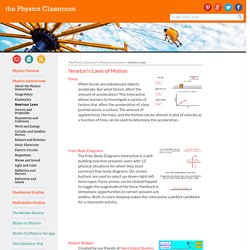
But what factors affect the amount of acceleration? This Interactive allows learners to investigate a variety of factors that affect the acceleration of a box pushed across a surface, The amount of applied force, the mass, and the friction can be altered. A plot of velocity as a function of time can be used to determine the acceleration. Free-Body Diagrams The Free-Body Diagrams Interactive is a skill-building tool that presents users with 12 physical situations for which they must construct free-body diagrams.
Rocket Sledder Created by our friends at Nerd Island Studios, this Interactive illustrates the effect of friction, air resistance, and applied force upon a sledder. Skydiving Created by our friends at Nerd Island Studios, this Interactive allows the learner to explore the motion of an object falling under the influence of air resistance. Everyone is fascinated by pulleys. Acceleration vs. Constant Velocity. Observe the animation of the three cars below.
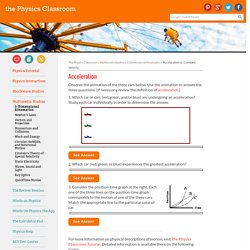
Use the animation to answer the three questions. (If necessary, review the definition of acceleration.) Magnets and Electromagnets - Magnetism, Magnetic Field, Electromagnets. Topics Magnetic Field Magnets Electromagnets Description Explore the interactions between a compass and bar magnet.
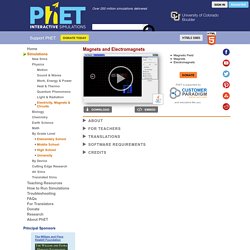
Discover how you can use a battery and wire to make a magnet! Can you make it a stronger magnet? Sample Learning Goals. Balloons and Static Electricity - Electricity, Static Electricity, Electric Charges. Electric Field Hockey - Electricity, Electric Field, Electric Charges. Topics Electricity Electric Charges Electric Field Description Play hockey with electric charges.

Place charges on the ice, then hit start to try to get the puck in the goal. Faraday's Law - Magnetism, Magnetic Field, Electricity. Topics Faraday's Law Magnetic Field Magnets Description Investigate Faraday's law and how a changing magnetic flux can produce a flow of electricity!

Sample Learning Goals. Generator - Generator, Magnetism, Magnetic Field. Magnet and Compass - Magnetism, Magnetic Field, Magnets. Magnets and Electromagnets - Magnetism, Magnetic Field, Electromagnets. Faraday's Electromagnetic Lab - Magnetism, Magnetic Field, Faraday's Law. Topics Faraday's Law Magnetic Field Magnets Description Play with a bar magnet and coils to learn about Faraday's law.
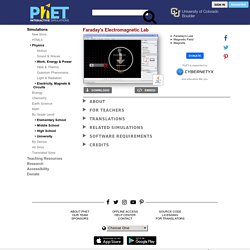
Move a bar magnet near one or two coils to make a light bulb glow. View the magnetic field lines. Sample Learning Goals Predict the direction of the magnetic field for different locations around a bar magnet and an electromagnet.Compare and contrast bar magnets and electromagnets.Identify the characteristics of electromagnets that are variable and what effects each variable has on the magnetic field's strength and direction.Relate magnetic field strength to distance quantitatively and qualitatively.Identify equipment and conditions that produce induction.Compare and contrast how both a light bulb and voltmeter can be used to show characteristics of the induced current.Predict how the current will change when the conditions are varied.